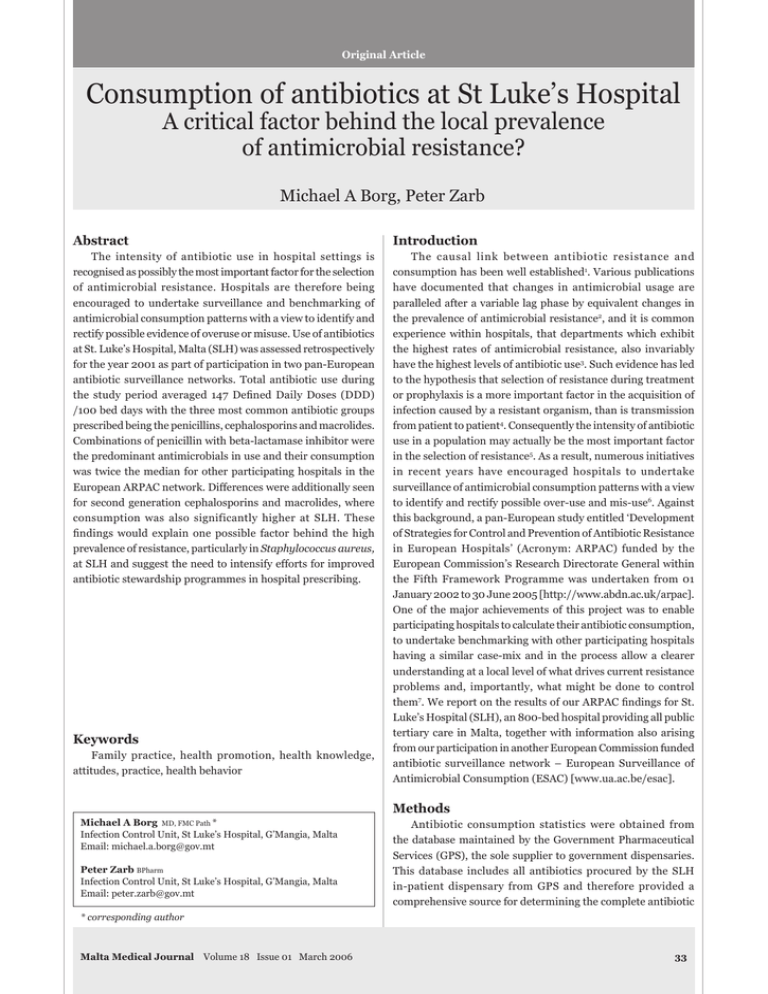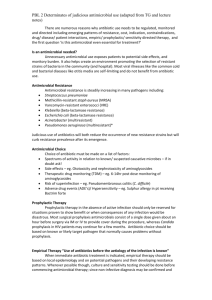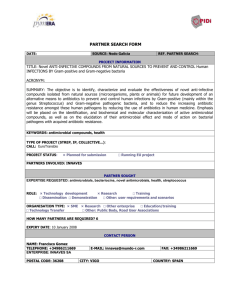Michael A Borg, Peter Zarb Abstract Introduction
advertisement

Original Article Consumption of antibiotics at St Luke’s Hospital A critical factor behind the local prevalence of antimicrobial resistance? Michael A Borg, Peter Zarb Abstract Introduction The intensity of antibiotic use in hospital settings is recognised as possibly the most important factor for the selection of antimicrobial resistance. Hospitals are therefore being encouraged to undertake surveillance and benchmarking of antimicrobial consumption patterns with a view to identify and rectify possible evidence of overuse or misuse. Use of antibiotics at St. Luke’s Hospital, Malta (SLH) was assessed retrospectively for the year 2001 as part of participation in two pan-European antibiotic surveillance networks. Total antibiotic use during the study period averaged 147 Defined Daily Doses (DDD) /100 bed days with the three most common antibiotic groups prescribed being the penicillins, cephalosporins and macrolides. Combinations of penicillin with beta-lactamase inhibitor were the predominant antimicrobials in use and their consumption was twice the median for other participating hospitals in the European ARPAC network. Differences were additionally seen for second generation cephalosporins and macrolides, where consumption was also significantly higher at SLH. These findings would explain one possible factor behind the high prevalence of resistance, particularly in Staphylococcus aureus, at SLH and suggest the need to intensify efforts for improved antibiotic stewardship programmes in hospital prescribing. The causal link between antibiotic resistance and consumption has been well established1. Various publications have documented that changes in antimicrobial usage are paralleled after a variable lag phase by equivalent changes in the prevalence of antimicrobial resistance2, and it is common experience within hospitals, that departments which exhibit the highest rates of antimicrobial resistance, also invariably have the highest levels of antibiotic use3. Such evidence has led to the hypothesis that selection of resistance during treatment or prophylaxis is a more important factor in the acquisition of infection caused by a resistant organism, than is transmission from patient to patient4. Consequently the intensity of antibiotic use in a population may actually be the most important factor in the selection of resistance5. As a result, numerous initiatives in recent years have encouraged hospitals to undertake surveillance of antimicrobial consumption patterns with a view to identify and rectify possible over-use and mis-use6. Against this background, a pan-European study entitled ‘Development of Strategies for Control and Prevention of Antibiotic Resistance in European Hospitals’ (Acronym: ARPAC) funded by the European Commission’s Research Directorate General within the Fifth Framework Programme was undertaken from 01 January 2002 to 30 June 2005 [http://www.abdn.ac.uk/arpac]. One of the major achievements of this project was to enable participating hospitals to calculate their antibiotic consumption, to undertake benchmarking with other participating hospitals having a similar case-mix and in the process allow a clearer understanding at a local level of what drives current resistance problems and, importantly, what might be done to control them7. We report on the results of our ARPAC findings for St. Luke’s Hospital (SLH), an 800-bed hospital providing all public tertiary care in Malta, together with information also arising from our participation in another European Commission funded antibiotic surveillance network – European Surveillance of Antimicrobial Consumption (ESAC) [www.ua.ac.be/esac]. Keywords Family practice, health promotion, health knowledge, attitudes, practice, health behavior Methods Michael A Borg MD, FMC Path * Infection Control Unit, St Luke’s Hospital, G’Mangia, Malta Email: michael.a.borg@gov.mt Peter Zarb BPharm Infection Control Unit, St Luke’s Hospital, G’Mangia, Malta Email: peter.zarb@gov.mt Antibiotic consumption statistics were obtained from the database maintained by the Government Pharmaceutical Services (GPS), the sole supplier to government dispensaries. This database includes all antibiotics procured by the SLH in-patient dispensary from GPS and therefore provided a comprehensive source for determining the complete antibiotic * corresponding author Malta Medical Journal Volume 18 Issue 01 March 2006 33 Table 1: Consumption of antibiotics within SLH by antimicrobial group Antibiotic Penicillins (all) • Wide spectrum • Narrow spectrum • Beta-lactamase stable • With beta-lactamase inhibitor Cephalosporins (all) • First-generation • Second-generation • Third-generation Carbapenems Macrolides Aminoglycosides Quinolones Glycopeptides DDD/100 bed days 47.43 5.47 1.28 1.41 39.26 16.59 3.49 9.67 3.42 1.51 8.66 1.71 6.85 0.47 use at SLH for the 12 months of the year 2001. The data was retrieved from its original SAGEline 100 software (version 5.20a, Sage UK) and converted to a text file. The file was then opened and subsequently saved in an Excel format (Microsoft Excel 97, Microsoft Corp.) to allow adaptation of the in-house codes to the Anatomical Therapeutic Chemical (ATC) classification and, by further processing, converted to Defined Daily Doses (DDD). This methodology has been developed, validated and is maintained by the WHO Collaborating Centre in Oslo, Norway [http://www.whocc.no]. The ATC/DDD 2002 version was used as a reference, as set by the ARPAC protocol. Bed day statistics were obtained from the hospital Data Management Unit thus allowing consumption to be reported in DDD per 100 bed days, a standardised figure allowing comparison between different institutions. Statistical analysis was undertaken by means of the one-sample t-test using SPSS software version 13 (SPSS Inc, USA). Results Total antibiotic use at SLH during the study period averaged 147 DDD/100 bed days. The results indicated that the three most common antibiotic groups used at SLH in 2001 were penicillins, cephalosporins and macrolides (Table 1). Heaviest utilisation was evident for the penicillin group of antibiotics which accounted for almost a third of all antimicrobials used, with a consumption rate of 47.3 DDD/100 bed days. Of these, more than 80% were broad-spectrum penicillin plus betalactamase inhibitor combinations (PBLI), which consisted almost exclusively of co-amoxiclav. The bulk of cephalosporin use was the result of cefuroxime, the only second generation cephalosporin in use at St. Luke’s Hospital; this accounted for more than half of all cephalosporin consumption. Compared to the beta-lactams, macrolide use was considerably less at 8.66 DDD/100 bed days. Several trends were apparent when the data for SLH was collated within the overall results of the two networks, as FI: Finland, FR: France, MT: Malta, BE: Belgium, PL: Poland, GR: Greece, LU: Luxembourg, HR: Croatia, SI: Slovenia, DK: Denmark, SK: Slovakia, SW: Sweden, HU: Hungary, NO: Norway. Figure 1: Total antibiotic use during 2001 within hospital participating in the ESAC project (MT = Malta/SLH) Reproduced with permission 34 Malta Medical Journal Volume 18 Issue 01 March 2006 Figure 2: Antibiotic consumption of various classes in DDD/100 bed days for SLH and median consumption for the overall hospitals in the ARPAC study and for the sub-group of hospitals in the South of Europe Figure 3: Use of penicillin class antibiotics during 2001 within hospital participating in the ESAC project (MT = Malta/SLH) Reproduced with permission Malta Medical Journal Volume 18 Issue 01 March 2006 35 provided through personal communications from Prof. H. Goossens [ESAC] and Dr. F. MacKenzie [ARPAC]. ESAC data for 2001 (Figure 1) indicated that per capita antibiotic use at SLH was second highest within the network (data from Finland was not directly comparable since it also included consumption in nursing homes). The local consumption of penicillins was twice as high on a per capita basis than the 22.06 DDD/100 bed days median reported in the ARPAC network (p<0.05) (Figure 2). This was evident when comparing with the overall project median as well as 24.51 DDD/100 bed days reported by the sub-group of hospitals from the South of Europe, which themselves were the group that had the highest consumption patterns. There was no significant difference in the consumption of penicillins with narrow spectrum (e.g. benzylpenicillin); wide spectrum (e.g. amoxicillin) or which are beta-lactamase stable (e.g. flucloxacillin). The difference was almost exclusively the result of the use of PBLI’s, specifically co-amoxiclav, which at 39.26 DDD/100 bed days was more than three times higher than the overall ARPAC median and twice as much as that found in Southern European hospitals. The considerable local emphasis on wide spectrum penicillins was also apparent from the ESAC data which showed the proportion of PBLI’s at SLH to be amongst the highest in all the participating European hospitals (Figure 3). On the other hand, the overall consumption of cephalosporins at SLH did not exhibit significant differences from the median ARPAC consumption although there was a considerable variation when compared to that reported by Northern European hospitals where 75% of institutions reported use levels at less than 10 DDD/100 bed days. What was however noted was the disproportionate emphasis on second generation cephalosporins in SLH, which, at 9.67 DDD/100 bed days, was almost three times higher than the median reported in the project. Similar differences were also found for macrolide use. On the other hand, SLH consumption of other antibiotic groups such as aminoglycosides, quinolones and carbapenems were either on par with the overall values reported by the ARPAC project team or actually lower, particularly when compared to the medians of Southern European participating hospitals. Discussion Data from the European Antimicrobial Resistance Surveillance System (EARSS – www.earss.rivm.nl) indicates Malta to have the highest per capita incidence of methicillin resistant Staphylococcus aureus (MRSA) bacteraemia amongst the participating European countries (Figure 4). Whilst the fact that Malta data originates from a single hospital with lower blood culture sampling frequencies may to some extent contribute to skew the data, the results nevertheless point towards a significant incidence of multi-resistant infections, particularly MRSA. In addition, there is little doubt that factors that promote spread of microorganisms within the hospital, particularly overcrowding, are important contributors to the prevalence of nosocomial resistant infections within SLH8. However, it is equally probable that, as evidenced in hospitals in other countries, the high level of antibiotic consumption identified at SLH is an important driver for the advent and proliferation of resistance9. This situation is compounded by the indication from our data that this above average consumption of antimicrobials resides predominantly in the wider spectrum formulations that are known to pose a greater risk of the development of resistance than alternatives with a narrower anti-bacterial spectrum of activity10. Several studies have identified the development of resistance associated with the three antimicrobial groups showing significant differences in consumption at SLH; namely co-amoxiclav11, cefuroxime12, and macrolides13. More specifically, it would appear that their NO: Norway, SE: Sweden, EE: Estonia, NL: Netherlands, FI: Finland, CZ: Czech Republic, PL: Poland, HU: Hungary, BG: Bulgaria, LV: Latvia, RO: Romania, SI: Slovenia, SK: Slovakia, DE: Germany, ES: Spain, HR: Croatia, IT: Italy, GR: Greece, BE: Belgium, CY: Cyprus, UK: United Kingdom, FR: France, IE: Ireland, IL: Israel, PT: Portugal, MT: Malta Figure 4: Average MRSA incidence per 1000 patient bed days in European countries participating in the EARSS network (MT = Malta/SLH). Adapted with permission from EARSS Annual Report 2004.14 36 Malta Medical Journal Volume 18 Issue 01 March 2006 Table 2: Key recommendations of the WHO Global Strategy for Containment of Antimicrobial Resistance22 1. Educate all groups of prescribers and dispensers (including drug sellers) in the importance of appropriate antimicrobial use and containment of antimicrobial resistance; 2. Promote targeted undergraduate and postgraduate educational programmes for all health care workers, veterinarians, prescribers and dispensers on accurate diagnosis and management of common infections; 3. Encourage prescribers and dispensers to educate patients on antimicrobial use and the importance of adherence to prescribed treatments; 4. Improve of antimicrobial use by supervision and support of clinical practices, especially diagnostic and treatment strategies. 5. Monitor prescribing and dispensing practices and utilize peer group or external standard comparisons to provide feedback and endorsement of appropriate antimicrobial prescribing; 6. Encourage development and use of guidelines and treatment algorithms to foster appropriate use of antimicrobials; 7. Empower formulary managers to limit antimicrobial use to the prescription of an appropriate range of selected antimicrobials; 8. Link professional registration requirements for prescribers and dispensers to requirements for training and continuing education. 9. Establish effective Antibiotic Committees with responsibility for oversight of antimicrobial use in hospitals; 10. Develop and regularly update guidelines for antimicrobial treatment and prophylaxis, and hospital antimicrobial formularies; 11. Monitor antimicrobial usage, including quantity and patterns of use; and feed back results to prescribers; 12. Ensure on-site availability of microbiology laboratory services which are appropriately matched to the level of the hospital (e.g. secondary, tertiary); 13. Ensure performance and quality assurance of appropriate diagnostic tests, bacterial identification, antimicrobial susceptibility tests of key pathogens, and timely and relevant reporting of results. 14. Ensure that laboratory data are recorded (preferably on a database) and are used to produce clinicallyand epidemiologically-useful surveillance reports of resistance patterns among common pathogens and infections in a timely manner and feed back to prescribers and the Infection Control Programme; 15. Make the containment of antimicrobial resistance a national priority through the creation of a national intersectoral task force to raise awareness about antimicrobial resistance, organise data collection and allocate resources to promote the implementation of interventions to contain resistance including appropriate utilisation of antimicrobial drugs, control and prevention of infection, and research activities. Malta Medical Journal Volume 18 Issue 01 March 2006 use might be a relevant risk factor for the development of MRSA in hospital settings. Snowcroft and colleagues showed through multivariate analysis that the incidence of nosocomial MRSA rose with increasing use of co-amoxiclav in their institution14. Monnet and colleagues also identified dynamic, temporal relationships between monthly %MRSA and macrolide use9. Both studies also identified quinolone consumption as another risk factor for MRSA; our data, however, did not indicate local consumption for quinolones to be significantly higher than the other hospitals in the ARPAC study. Nevertheless, EARSS data have shown a statistically significant increasing frequency of quinolone resistance in local blood culture isolates of Escherichia coli over the past 4 years15. Furthermore, the prevalence of quinolone resistant E. coli in Malta was the highest in all the countries in the network. Dynamic selection of fluoroquinolone resistance has been demonstrated concurrently in both Staphylococcus aureus as well as E. coli16. It would therefore be reasonable to postulate that quinolone use, which is known to be the critical factor for the development of antibiotic resistance in E. coli17, may be equally involved in the epidemiology of MRSA in SLH. We believe that the use of co-amoxiclav is likely to be the result of its excessive dependence in empiric first-line therapy. Macrolide consumption is probably directly linked to the firstline therapy of community-acquired pneumonia whilst second generation cephalosporins are the mainstay of antimicrobial prophylaxis in surgery. If corrective action is to be successful, these are therefore the areas that need to be addressed. Monnet has proposed, through mathematical modelling, that in environments (such as SLH) where there is both a high prevalence of resistance as well as evidence of heavy antibiotic consumption, the area of improvement that is likely to have the biggest impact on resistance is control of antibiotic use18. Such improvement can be obtained through antibiotic stewardship programmes (Table 2) which aim to ensure that the use of antibiotics in hospitals is commensurate to the clinical circumstances and the local resistance epidemiology19. To this end, antimicrobial guidelines have been formulated after multistakeholders consultation20. Assessment of their impact on consumption patterns, as well as ultimately bacterial resistance, should be the end goal of the immediate and longer-term future. In addition, concurrent evidence of antibiotic misuse at community level21, would suggest the need for educational activities on proper use of this key pharmaceutical class at both prescriber and user levels on a national basis. Acknowledgements We would like to thank Dr. F. MacKenzie for providing overall ARPAC data, Prof H. Goossens for allowing reproduction of ESAC graphs and Dr. N. van der Sande for granting permission to utilise EARSS data. We would also like to acknowledge the support of Ms. E. Scicluna, the Government Pharmaceutical Services and the SLH Data Management Unit in data collection and analysis. 37 References 1. McGowan JE Jr. Antimicrobial resistance in hospital organisms and its relation to antibiotic use. Rev Infect Dis. 1983; 5:1033-48. 2. Lopez-Lozano JM, Monnet DL, Yague A, Burgos A, Gonzalo N et al. Modelling and forecasting antimicrobial resistance and its dynamic relationship to antimicrobial use: a time series analysis. Int J Antimicrob Agents. 2000; 14:21-31. 3. Shlaes DM, Gerding DN, John JF Jr, Craig WA, Bornstein DL et al. Society for Healthcare Epidemiology of America and Infectious Diseases Society of America Joint Committee on the Prevention of Antimicrobial Resistance: guidelines for the prevention of antimicrobial resistance in hospitals. Clin Infect Dis. 1997; 25:584-99. 4. Olson B, Weinstein RA, Nathan C, Gaston MA, Kabins SA. Epidemiology of endemic Pseudomonas aeruginosa : why infection control efforts have failed. J Infect Dis 1987; 150: 808-816 5. Levy SB. Balancing the drug-resistance equation. Trends Microbiol 1994; 2: 341-342. 6. Council recommendation on the prudent use of antimicrobial agents in human medicine (2002/77/EC). Brussels: European Commission, 2001. 7. MacKenzie FM, Struelens MJ, Towner KJ, Gould IM; ARPAC Steering Group; ARPAC Consensus Conference Participants. Report of the Consensus Conference on Antibiotic Resistance; Prevention and Control (ARPAC). Clin Microbiol Infect. 2005; 11:938-54. 8. Borg MA. Bed occupancy and overcrowding as determinant factors in the incidence of MRSA infections within general ward settings. J Hosp Inf 2003; 54:316-8 9. Monnet DL, MacKenzie FM, Lopez-Lozano JM, Beyaert A, Camacho M et al. Antimicrobial drug use and methicillin-resistant Staphylococcus aureus, Aberdeen, 1996-2000. Emerg Infect Dis. 2004;10:1432-41. 10.Lieberman JM. Appropriate antibiotic use and why it is important: the challenges of bacterial resistance. Pediatr Infect Dis J. 2003;22:1143-51. 11. Sotto A, De Boever CM, Fabbro-Peray P, Gouby A, Sirot D et al. Risk factors for antibiotic-resistant Escherichia coli isolated from hospitalized patients with urinary tract infections: a prospective study. J Clin Microbiol. 2001; 39:438-44. 38 12.Leibovici L, Berger R, Gruenewald T, Yahav J, Yehezkelli Y, et al. Departmental consumption of antibiotic drugs and subsequent resistance: a quantitative link. J Antimicrob Chemother. 2001; 48:535-40. 13.Berg HF, Tjhie JH, Scheffer GJ, Peeters MF, van Keulen PH et al. Emergence and persistence of macrolide resistance in oropharyngeal flora and elimination of nasal carriage of Staphylococcus aureus after therapy with slow-release clarithromycin: a randomized, double-blind, placebo-controlled study. Antimicrob Agents Chemother. 2004; 48:4183-8. 14.Crowcroft NS, Ronveaux O, Monnet DL, Mertens R. Methicillinresistant Staphylococcus aureus and antimicrobial use in Belgian hospitals. Infect Control Hosp Epidemiol. 1999; 20:31-6. 15.EARSS Management Team. EARSS Annual Report 2004. Bilthoven: RIVM 2005; 410-417 16.Gilbert DN, Kohlhepp SJ, Slama KA, Grunkemeier G, Lewis G et al. Phenotypic resistance of Staphylococcus aureus, selected Enterobacteriaceae, and Pseudomonas aeruginosa after single and multiple in vitro exposures to ciprofloxacin, levofloxacin, and trovafloxacin. Antimicrob Agents Chemother. 2001; 45:883-92. 17.Carratala J, Fernandez-Sevilla A, Tubau F, Callis M, Gudiol F. Emergence of quinolone-resistant Escherichia coli bacteremia in neutropenic patients with cancer who have received prophylactic norfloxacin. Clin Infect Dis. 1995; 20:557-60. 18.Monnet DL. Toward multinational antimicrobial resistance surveillance systems in Europe. Int J Antimicrob Agents. 2000; 15:91-101. 19.MacDougall C, Polk RE. Antimicrobial stewardship programs in health care systems. Clin Microbiol Rev. 2005; 18:638-56. 20.Borg MA, Cuschieri P, Mallia Azzopardi C, Zarb P. Antimicrobial Prescribing Guidelines. Malta: Health Division 2004 21.Borg MA, Scicluna EA. Over-the-counter acquisition of antibiotics in the Maltese general population. Int J Antimicrob Agents. 2002; 20:253-7 22.Anon. WHO Global Strategy for Containment of Antimicrobial resistance. Geneva: World Health Organisation 2001 Malta Medical Journal Volume 18 Issue 01 March 2006





